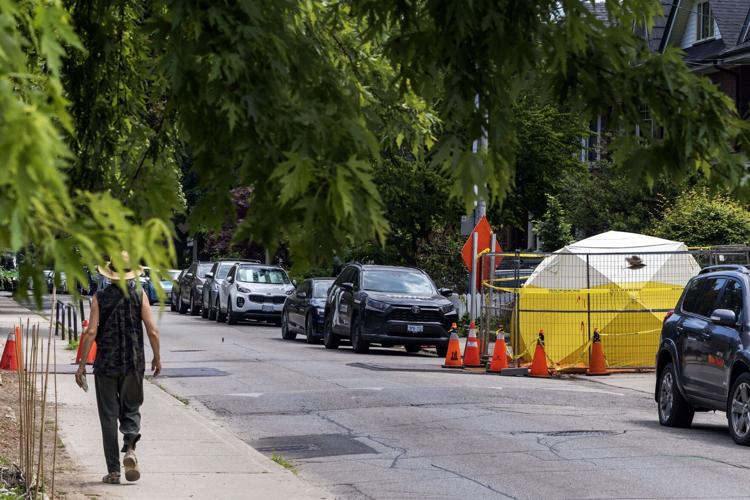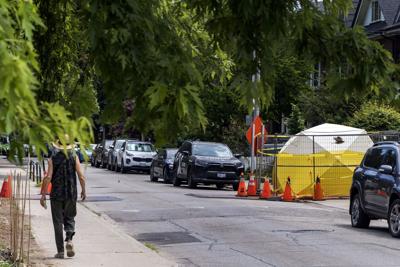A van┬Āslows to a stop on Withrow Avenue where one lane of traffic is blocked by fencing, which houses a large white and yellow tent, surrounded by a flurry of traffic cones and police tape. A man leans out of the van, propped up on his elbow, as he signals for the attention of a Logixx Security guard standing at the fence.
“Hey man, I’ve got to ask ŌĆö why the hell did they hire you to look at this tent?” the man in the car says.
It’s a question the security guard ŌĆö who requested the Star withhold his name, as he is not authorized to speak to media ŌĆö gets asked multiple times a day, as he watches the tent to make sure it stays undisturbed. He tells them what he knows from his three weeks on the job: ancient Indigenous remains were uncovered there, and the city is currently investigating; no, he doesn’t know how much longer it will be, or when the tent will be gone.
And every 40 minutes, he takes photos and logs into his phone what did, or more often, did not, happen at the site.
“Usually, (something) does not happen, but we still have to look at the fence,” he said.
While it may seem monotonous, he is guarding something precious.
The ancient Indigenous remains of multiple people were discovered by a man who fell into a construction pit where city crews were servicing a water pipe on Withrow Avenue in early January, igniting an investigation into the remains’ origins that is still underway. Officials say this time is vital to make sure the investigation is done properly, and declined to provide any timeline for when it may conclude ŌĆö┬Ābut neighbours┬Āhave been left to wonder about the status of this work by the city, while the bill for security at the site has climbed to six figures.
Ron Williamson, founder of the archeological consulting company ASI Heritage, said it’s important to keep in mind these investigations should not be rushed.
“Imagine this is your ancestor, don’t you want to get this right?” he said. “This is something where you do this respectfully and you do this carefully and patiently, scientifically, in order to answer the questions properly.”
The coroner’s office were the first to dig into the remains’ origins in the days after their discovery.┬ĀDr. Dirk Huyer, OntarioŌĆÖs chief coroner, said in situations where remains are discovered, police are notified and will send photos from the scene to his office for analysis.
A forensic anthropologist then studied the photos to determine if they’re human or animal, ancient or recent, or if there appeared to have been foul play. The remains are believed to be Indigenous and ancient┬ĀŌĆö once┬ĀHuyer’s office determined this, they notified Indigenous nations with ties to the site and handed the investigation off to the Ontario┬ĀRegistrar for burial sites, who ordered the city to do its own investigation.
Officials have not confirmed whether the remains are connected to the┬ĀIndigenous remains and artifacts dating back an estimated 5,000 years that were found in the area of Withrow Avenue Junior Public School, which is across the street from where the recent Withrow Avenue discovery took place.
One newer part of this process, Huyer said, is that officials try to move the remains as little as possible, with experts travelling to them instead.
“We don’t want to disturb the burial, the ancestors and potentially the spirit, so we have made a decision to be cautious,” he said.┬Ā
Indigenous nations have fought for consultation in these investigations over decades, Williamson said. He cited a discovery of ancient Indigenous remains in Grimsby during the 1970s as a turning point, as the uproar over the mishandled case led to growing consultation with Indigenous nations.
“People were very unhappy that their ancestor’s remains were being excavated and they didn’t even know about it,” said Williamson. “That one event was one that really changed the way in which people looked at investigating Indigenous cemeteries.”
The remains of the Indigenous people found in Grimsby were reburied┬ĀŌĆö a rare practice at the time, he said, as remains were often taken by universities who aided in their excavation and “assumed that they had a right to these remains.”
Tanya Hill-Montour, the archeological supervisor for Six Nations of the Grand River who has been consulting on investigations into the Withrow remains, told the Star earlier this year that challenges still remain in provincial regulations for Indigenous groups seeking autonomy over decisions made about their ancestors’ remains. She said sheŌĆÖs fighting back ŌĆ£all the timeŌĆØ against this, and is working with other Indigenous communities to develop guidelines on how to improve this process, which they plan to present to the provincial government.
The City of ╬┌č╗┤½├Į said it has yet to begin the investigation┬ĀŌĆö which it previously told the Star was on hold until the ground thawed, and said is now pending the finalization of agreements with local First Nations on how to proceed. City spokesperson Laura McQuillan said the city began consulting with First Nations in March, who submitted their own proposal, and there has been ongoing discussions with those groups and the city’s consultant,┬ĀArcheological Research Associates, on how best to approach this work.
Part of the agreement will focus on how to compensate experts from the First Nations for their archeological work, review of any reports, and potentially travel costs, McQuillan said.
“Given there are agreements that are yet to be finalized and the Burial Site Investigation has yet to begin, there are a number of unknowns that may impact the timeline for completion and compliance with the requirements of the provincial order,” she said.
The Star reached out to First Nations with claims to the area for this story and earlier reporting, several of whom declined to respond. Rose-Marie Ayotte, in a statement on behalf of the Huron-Wendat Nation, said, ŌĆ£itŌĆÖs really important for us not to take any public position while the investigation is going on.ŌĆØ
One key question still unanswered is which nation’s ancestors were found. Hill-Montour┬Ātold the Star earlier this year that it will be difficult to determine, due to the area’s shared history.
As of June 12, the city has spent┬Ā$110,955 on 24/7 security at the Withrow Avenue site.
Alex Stasyk, 68, whose house is next to where the remains were found and has lived in the neighbourhood for more than 60 years, said he hasn’t heard anything from the city since the remains were found┬ĀŌĆö he just knows what has been reported in the media.┬Ā
“I have a lot of questions myself,” he said. “I’ve just been asking the security guard, and they don’t know a hell of a lot.”
Many of the neighbours have been supportive of the city working alongside Indigenous communities to investigate the remains. But Stasyk said it hasn’t been communicated why it’s taking so long for officials to move forward with the investigation, and reinterring the remains as the First Nations decide what is best.
There’s a lot still that will likely have to be decided,┬ĀWilliamson said, including if the investigation will look beyond the immediate area of the discovery, if the water pipe will need to be moved from the burial site, and where Indigenous leaders would like to see the remains reinterred, either at the current site or elsewhere. All that, he says, will take more time.
“Everybody’s going to want to be sure that nothing more is disturbed,” he said. “Let’s get this right.”
































To join the conversation set a first and last name in your user profile.
Sign in or register for free to join the Conversation